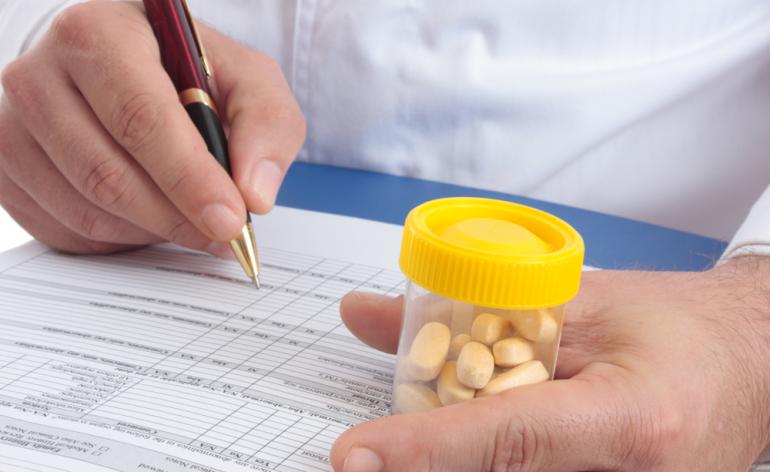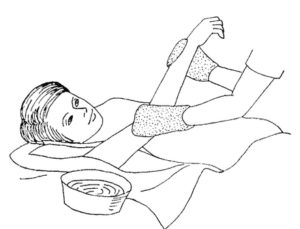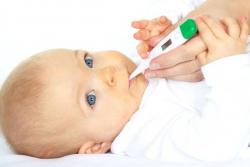Causes
You can name a truly huge number of probable reasons for an increase in body temperature - among them intoxication, radiation damage, endocrine disorders and malignant neoplasms. Still, a temperature of 40 ° C in an adult makes you think first of all about the infection. Infectious pathologies are distinguished by a variety of clinical signs, and one of the determining factors in the course of the disease is immune reactivity - a reaction to the penetration of pathogenic agents. Fever in this case is an example of a typical protective and adaptive process and is characterized by similar manifestations in various types of infectious diseases.
A temperature from 39 to 40 degrees is called febrile; it is necessary to assume the diagnosis, relying not only on the figures of temperature indicators, but also taking into account the symptoms that are observed in the patient. The most striking examples of infectious diseases accompanied by febrile fever are:
- Flu.
- Typhus.
- Infectious mononucleosis.
In an adult, a temperature of 40 ° C without symptoms may be the initial sign of hyperthyroidism (increased functional activity of the thyroid gland), leukemia (tumor disease of the hematopoietic tissue).
Rare cases of febrile fever without other manifestations are recorded in athletes. A temperature of about 40 ° C without symptoms sometimes characterizes the course of systemic lesions of the connective tissue.
Flu
This is a lesion of the respiratory system of an infectious etiology that occurs when infected with the influenza virus. The transmission mechanism is airborne, contact. The virus is secreted by a sick person with particles of saliva, sputum. Frequent and dangerous complication becomes pneumonia (inflammation of the lung tissue). The following symptoms are characteristic:
- Weakness, headache.
- Muscle pain.
- Decreased appetite.
- Fever.
- Runny nose, cough.
The headache is concentrated in the forehead, worse with eye movement. If pneumonia develops, persistent fever, shortness of breath, cough with frothy bloody sputum appear.
What to do when temperatures reach 40 ° C and above? A medical emergency is required. The patient must be in bed; physical activity is excluded, abundant drink is provided (tea, water, rosehip broth, etc.). Antipyretic drugs (ibuprofen, paracetamol), interferon preparations, oseltamivir or remantadine, glucocorticosteroids (prednisolone) are used, detoxification therapy (glucose solution, rheopolyglucin), oxygen therapy are used.
Typhus
It's spicy infectioncaused by Provachek's rickettsia. The carriers of the pathogen are lice (most often clothes or head lice) that bite a sick person. Infection occurs when lice feces are rubbed into scratches on the skin, in the digestive tract of which rickettsiae multiply. With particles of nasal or bronchial secretions, the fecal-oral route, typhus is not transmitted. is about 2 weeks.
Symptoms:
- headache;
- weakness, dizziness, shortness of breath;
- lack of appetite, vomiting;
- anxiety, agitation;
- muscle pain, dry mouth, thirst;
- insomnia or sleep with nightmares;
- temperature rise to 39-40 ° C;
- the appearance of a rash.
 The headache is excruciating, aggravated by a change in body position and during a conversation. Roseolous-petechial rash is observed from 4-6 days of the disease, localized behind the ears, as well as on the lateral surfaces of the neck, trunk, inner thighs, flexion surface of the upper extremities. A gray or brown coating appears on the tongue. The face looks puffy, the eyes turn red ("rabbit"). The liver and spleen are enlarged (hepatosplenomegaly). With an increase in temperature, disturbances of consciousness in the form of delirium, hallucinations may occur.
The headache is excruciating, aggravated by a change in body position and during a conversation. Roseolous-petechial rash is observed from 4-6 days of the disease, localized behind the ears, as well as on the lateral surfaces of the neck, trunk, inner thighs, flexion surface of the upper extremities. A gray or brown coating appears on the tongue. The face looks puffy, the eyes turn red ("rabbit"). The liver and spleen are enlarged (hepatosplenomegaly). With an increase in temperature, disturbances of consciousness in the form of delirium, hallucinations may occur.
Treatment is carried out only in an infectious hospital. She needs bed rest until the temperature returns to normal, plenty of drink.
Apply antibacterial therapy (doxycycline, tetracycline), intravenous infusion saline and glucose, sedatives (diazepam), anticoagulants (heparin).
Infectious mononucleosis
An infectious disease provoked by the human herpesvirus type 4. Infection is carried out by airborne droplets and by contact, the source of infection is a patient or a virus carrier. The duration of the incubation period is from 4 to 50 days.
The onset is acute; patients are worried about weakness, decreased appetite, sore throat, swollen lymph nodes (cervical, occipital, submandibular). A dirty gray or yellowish coating appears on the swollen tonsils. Nasal breathing is difficult, the voice is nasal. Hepatosplenomegaly and jaundice are noted. Fever can be both subfebrile and febrile and lasts from several days to 4 weeks.
What if an adult's temperature rises to 40 ° C? Patients with infectious mononucleosis with febrile fever with jaundice, hospitalized. Requires abundant drink, diet (table number 5), rinsing the oropharynx with antiseptic solutions. Use alpha interferon, acyclovir, antibacterial drugs (clarithromycin, cefepime), antipyretics (paracetamol, ibuprofen).
An increase in body temperature always indicates that viral agents invade the child's body, to which he reacts in his own way, trying to cope with pests on his own. Such a reaction of the body, first of all, indicates that the immune system reacts correctly to "uninvited guests", therefore, doctors all over the world do not recommend giving the patient any antipyretic drugs up to 38.5 ° C. It is best to allow the child's body to cope with the virus on its own, while helping him with this. Among the mandatory activities that parents must follow are drinking plenty of fluids, airing and humidifying the room. But what should parents do if the temperature begins to rise rapidly. What to do if First of all - do not panic. And to answer all these questions, you need to remember a few rules.
Why does a child's body temperature rise rapidly
A rapid increase in temperature in a child can be caused by bacteria and viruses, which is typical for ARVI, sore throat, pneumonia and some other diseases that are associated with the respiratory system. However, a sharp increase can cause an attack of appendicitis or an intestinal infection. However, children may complain about pain in the abdomen, for nausea and even vomiting. Sometimes diarrhea appears and the skin becomes pale.
That such a condition may also indicate the development of pyelonephritis or an infection of the urinary tract, which requires the immediate intervention of doctors and treatment in a hospital. Therefore, you should not independently diagnose the child's condition and prescribe pills to treat the symptoms. Remember, symptoms are not treated, only disease is treated. And in order to make the correct diagnosis, you first need to call a doctor.
Rules of conduct for parents before the arrival of the doctor
If the child's temperature rises sharply, then you always need to remain calm, which will allow the parents to take adequate measures before the doctor arrives. So, the child's temperature is 40, what should parents do? As mentioned above, call an ambulance doctor or district pediatrician. Before the arrival of the doctor, parents should relieve the baby's condition and proceed as follows.
1. Reassure the baby and convince him that nothing terrible has happened, and now together you will try to cope with this symptom. The child must believe that he can do everything to improve his condition before the arrival of the doctor.
2. Provide the baby with plenty of drink - fruit drinks, warm compotes, unsweetened teas - everything that is at hand.
 3. Rubdown. The wiping method not only improves the well-being of the baby, but also helps to reduce the temperature. For this purpose alone, never use vinegar or vodka. Plain water at room temperature and a soft towel. Soak a towel in water and wipe off the patient's hands and feet, armpits and groin areas. Then, with gentle movements, repeat the movements along the back and chest... You can soak the diaper in room temperature water and put it on the baby's forehead.
3. Rubdown. The wiping method not only improves the well-being of the baby, but also helps to reduce the temperature. For this purpose alone, never use vinegar or vodka. Plain water at room temperature and a soft towel. Soak a towel in water and wipe off the patient's hands and feet, armpits and groin areas. Then, with gentle movements, repeat the movements along the back and chest... You can soak the diaper in room temperature water and put it on the baby's forehead.
4. If u has risen to 40 ° C, then you can give him an antipyretic agent that matches his age. These can be syrups or candles. Just do not forget to inform the doctor about this upon his arrival!
5. A sick child with a high fever should not be wrapped in a blanket! Instead, put on light clothing and cover it with a light terry sheet.
The main danger, 40 ° C, is the possibility of seizures, which can cause other equally unpleasant consequences and cause a difficult effect of antipyretic drugs. This indicates that parents may unsuccessfully wait for the antipyretic drug to work, which sometimes forces them to act incorrectly - to give another portion of the antipyretic. This can lead to a sharp drop in temperature and cause another problem - hypothermia. Therefore, if the child's body temperature rises above 39 ° C, then syrups to lower the temperature should be warmed up to body temperature, which will allow them to be absorbed almost instantly, and alleviate the patient's condition.
But, what to do with a temperature of 40 in a child and vomiting appears? In this case, it is impossible to give the child antipyretic syrup. This will not only provoke vomiting in the future, but also will not bring any result regarding measures to reduce the temperature. In this case, it is better for the baby to introduce rectal suppositories, which in turn are also not suitable if the patient has diarrhea.
Injections, to lower the temperature, will allow in the shortest possible cases to lower the body temperature and alleviate the baby's condition. But only a doctor can administer the injection, who, first of all, will calculate the correct dose of the drug.
And, most importantly, if it reaches high rates, then throughout the entire illness try to be always near him and leave aside all other worries. The most important thing for him is the presence of his mother, her affection and love. Now he needs you more than ever, and this should always be remembered.
Remember that individual intolerance may appear to any drugs, which will manifest itself as vomiting, rash and dizziness. With these symptoms, you should immediately stop taking the prescribed medicines and report such a reaction to the attending physician.
An increase in body temperature is one of the signs of the disease, and if a child has a temperature of 40 degrees, then this is a threshold, exceeding which is a danger to life. It should be noted that experts believe that temperatures up to 38 degrees have a stimulating effect on the immune system. A higher temperature, especially if it lasts for several days, indicates a serious illness, it is likely that the baby, for example, has pneumonia. With such an increase in body temperature, body tremors (fever), convulsions, muscle tension in the trunk, and rolling of the eyes are often observed.
What to do if a child has a temperature under 40?
Temperature 40, especially if it is observed in an infant or one-year-old child, requires immediate treatment for medical help... In this case, calling a doctor or ambulance is obligatory! Before a doctor appears, you should try to lower the temperature to the permissible value of 38 degrees in order to protect the baby from seizures.
How to bring down the temperature of 40 for a child?
- The child must be put to bed, otherwise breathing and cardiovascular disorders may occur.
- An antipyretic agent should be given. It can be a liquid form of Paracetamol, Panadol or Cefekon in the form of a suspension. You can put rectal suppositories with antipyretic effect. Children's Nurofen is also recognized as effective means, but only the active substance contained in the indicated preparations acts in 40 minutes. If the child's temperature is above 40 for several days, the doctor may recommend taking Ibuklin, which is a complex of paracetamol and non-steroidal anti-inflammatory substances.
- When high temperatureaccompanied by chills, blanching of the skin, you should massage the baby's limbs, give him a hot drink (sweet tea, fruit drink, etc.) temperature, diluted with table vinegar (6% or 9%) in a ratio of 1 part vinegar to 4 parts water. Use for wiping cold water or doing a cool shower is not recommended because of the risk of vasospasm caused by a sharp temperature drop. It is advisable to place a damp cloth dipped in cool water on the forehead. In the most severe cases, pieces of ice wrapped in cellophane and a cotton napkin can be placed in the projection sites of large cervical vessels.
- Enemas with room temperature water help to reduce body temperature fairly quickly to the permissible level.
- An abundant drink is shown to increase the heat transfer of the body through profuse sweating (hot tea with raspberries or honey, sour fruit drink, dried fruit compote, rosehip decoction).
What can not be done at a high temperature in a child?

Advice: it is important not to overdo it with medicines, because exceeding the dose of the substances that make up them can be dangerous. Be sure to follow the dosage indicated in the instructions, and tell the doctor who came to the call what medicine you have already given to your baby.
